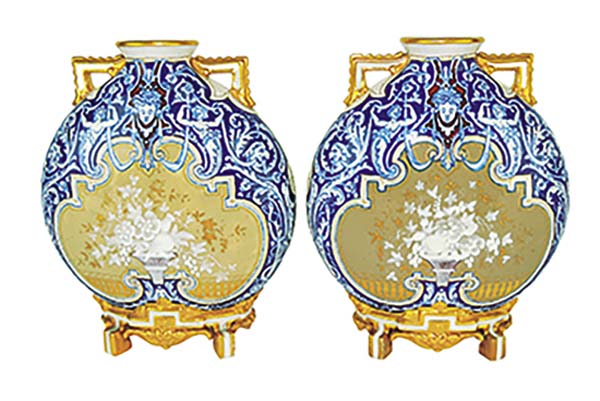Anyone who grew up in the New York-New Jersey metropolitan area will likely recognize the name Fortunoff, the high-end retailer of housewares, silverware, lighting fixtures and jewelry. Few are probably aware, however, that the matriarch of the Fortunoff family, Helene Fortunoff (1933-2021), was a passionate collector of fine antique ceramics. Now, the entire collection that Helene assembled with her second husband, Robert Grossman, will come up for bid in an online-only auction slated for Tuesday, April 23, starting at 6 p.m. Eastern time. The sale, comprising 243 lots, will be conducted by Strawser Auction Group. Online bidding will be via LiveAuctioneers.com. Absentee and telephone bids will also be accepted. The Strawser Auction Group facility is located at 200 N. Main St., in Wolcottville, Ind. The auction is titled The Fortunoff Collection of 19th-Century Aesthetic Movement Porcelain, reflecting the main focus of the collection. Helene had a passion for Japanese design and collected Japanese lacquer pieces. The specific styles in the auction were mostly inspired by Japan, includingimportant pieces designed by the Father of Modernism, Christopher Dresser. Although very large, the collection was very specific based on the highest quality, rarity and strength of design, said Nick Boston, a dealer who first met Helene and Robert in January 2007 at theNew York CeramicsFair. Helene had an eye for quality. Her background in jewelry passed on to her taste in porcelain. Boston called the collection without a doubt the finest collection of Aesthetic Movement porcelainin the world, one that focused mainly on Minton and Royal Worcesters Japan range, first introduced in 1862, and items from British manufacturers Copland, Royal Crown Derby and Coalport, companies who were supplying Gilded Age U.S. homes in the 19th century, furthered Boston. Numerous pieces in the auction are expected to vie foe top lot honors. Chief among them is a pair of rare Worcester porcelain Renaissance Revival pate sur pate moon flasks, ca. 1875, the white ground bodies decorated with a cobalt blue panel of Italianate masks, scrolls, caryatids and fantastic animal heads and each with a large panel of pate sur pate flowers. A large, ca. 1875 Royal Worcester Aesthetic Movement moon flask decorated with blue and white Japanese style fauna and a 22-carat gilded butterfly, all against a black ground with a 22-cart gilded scrolling dragon to the neck, should fetch $1,500-$2,500. The pair to this moon flask was donated by Fortunoff to the Metropolitan Museum of Art in New York, where it now resides. A pair of quality Royal Worcester Aesthetic Movement moon flasks, ca. 1875, each decorated in the Japanese Shibayama style depicting birds and blossoms against a speckled ivory ground, both with square section faux bronze handles, all upon faux hardwood style bases, were purchased at the New York Ceramics Fair 2002. Helenes son, David, said he can trace the collection to its beginnings when his mother and Robert were entertaining someone from the Fine Arts Society who noticed a moon flask that had been in the family for ages. He identified it as Christopher Dresser, David recounted, and he offered to buy it on the spot. This got Helenes attention right away, and she had to learn more. She started to research Christopher Dresser and went to a porcelain show in New York. Thats where she met Nick Boston, David said. Robert had noticed a moon flask similar to one he remembered from someones library in England. This drew them to the booth. Helene ended up buying out Nicks entire booth, and their friendship and Helenes interest was forever solidified. Robert and Helene found a new hobby they could enjoy together, and it could be an activity they pursued on their travels. The couple sought out antique dealers wherever they travelled, making purchases in England, Japan, Australia and New Zealand, among other places. As Robert once remarked, Wherever the British had lived, they were sure to have left some porcelain behind. Helenes collection,and the way it was displayed, was like the interior of a jewelry box, stated Boston. This is what these pieces were designed for, for the Gilded Age homes. The great 19th-century New York designers and decorators, the Herter Brothers, designed homes, for Vanderbilt for example,to look like the interior of a jewelry box. Helene accomplished this, cabinet after cabinet beautifully displayed and beautifullylit. It really was a sight to behold. Helene and Robert donated portions of their collection to the Metropolitan Museum of Art, Yale University and the Art Institute of Chicago. For a collector to have their collection displayedin a major museum is the highestaccolade, according to Boston. Helene was a visionary. She had incredible taste and was a very generous philanthropist. Her foresight and generosity have left a most incredible legacy in the world of 19th-centurydesign and ceramics. To learn more, call Michael Strawser at 260-854-2859 (office), email michael@strawserauctions.com, or visit www.strawserauctions.com.
Antiques & Auction News is owned and published by Engle Printing & Publishing Co., Inc. and is the source for marketplace news on art and antiques.











